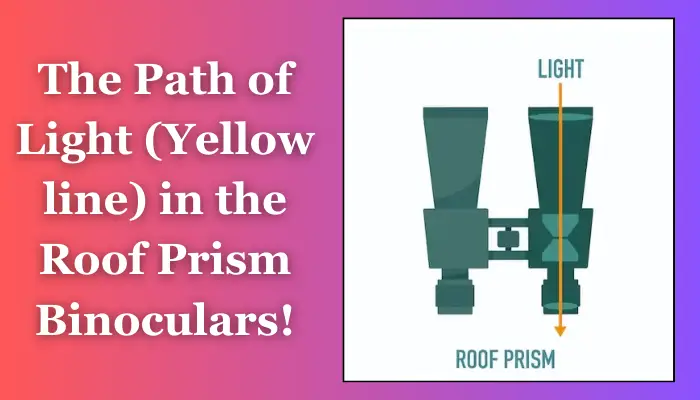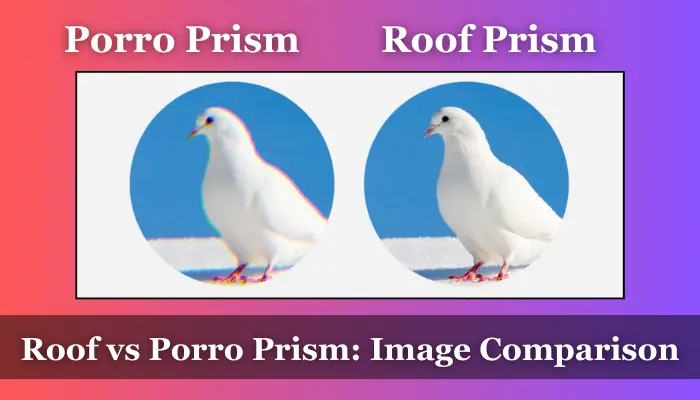This post may contain affiliate links which means I may receive a small commission for purchases made through the links. Learn More
Roof prism and the Porro prism binoculars are very famous among outdoor enthusiasts. Some people consider a roof to be a superior option while others prefer porro to a nice money-saving option. A newbie can easily get confused due to this difference in opinion.
So, which one is better, roof or Porro prism binoculars? Roof prism binoculars are better because they offer better optical performance, and are compact. You won’t feel tired while using them for a longer duration. The Porro prism binos are inexpensive and a good option for those who have tight money.
There is no doubt that both of these binos have their own good and bad. In this article, I will explain the differences between roof and Porro prism, and how they improve the quality of the binoculars. So stay till the last dot.
Related Article: What are ED (Extra-Low Dispersion) Binoculars?
Overview of Prism in Binoculars
Before I take you into the details of Porro and roof prism binos, it would be very important for you to understand the working, and functionality of the prism. They are used to reorient the image that comes from the objective lens of the binoculars.
As you know the objective lens is the part or component of the binoculars that captures the light. But it sends an inverted image to the prism. Here starts the magic of the prisms. First of all, the prism reflects the incoming light at 90 angle to change its direction.
There is another prism which again reflects the light to another 90-degree angle. The combined reflection and deviation of light happen up to 180-degree angles and the orientation of the images gets corrected.
This is how the prism works together to reflect the light at different angles, and ensures that the image’s orientations get corrected. The purpose of both Porro and roof prism is the same, but their way of working is slightly different which I am going to explain in the upcoming section.
To get more details about the prism, I suggest you read our other article on the purpose of a prism in binoculars.
Introduction to Roof, and Porro Prism
The roof and Porro prism serve the same purpose, but the roof prism is considered superior due to multiple reasons. However, the Porro prism is usually a cheaper option and is used in most mid-range binoculars.
The Porro prism is an older technology that was first invented by the Italian optician Ignazio Porro in the 19th century. However, right after the Porro prism, the roof prism was also invented which was known as the Schmidt-Pechan roof prism and it made good headlines in the 20th century.
Get detailed insight by readingng a comprehensive guide on the Porro Prism in Binoculars
The Porro prism binoculars were just a decent option, but they had nothing fancy. Their size was bigger and the overall look was also outdated. Even now, the Porro prism does not look modern. The roof prism binoculars are more compact, streamlined, and modern in looks.
The Porro prism reflects light at different angles and changes the traveling direction of light. So, the light travels in a zigzag pattern. On the opposite side, the roof prism ensures that the light travels in a straight line which makes the binoculars more compact.
If you are interested about the roof prism, make sure you read our other article dedicated on the roof prism in binoculars. You’ll get a lot more detailed information there.
Differences Between Roof and Porro Prism Binoculars
Hopefully, the information that I have provided in the above section will give you basic insight about the roof, and Porro prism. It is time to go into more detail and learn the differences between those binoculars that consist of a roof and a Porro prism.
1- Light travel
First, and one of the most prominent differences between the roof, and Porro prism is that the roof prism ensures that the light within the binoculars travels in a straight line. It enters through an objective lens, goes in a straight line to the prism, and then goes to the eyepiece in a streamline.

But in the porro prism, there happens a lot of reflection at different angles. The light does not travel in the streamline. Instead of traveling in a straight line, it moves in a zigzag manner before it reaches the eyepiece of the binoculars where the user sees the visuals.

As shown in the image above, light is going in a zigzag way, and making a ‘Z shaped’’ pattern within the binoculars. When the light travels in a zigzag manner, it is not a good thing in many ways. Ideally, the light should travel in a streamlined as it is good for both optical performance and compactness of the size.
Winner: Roof Prism Binoculars
2- Optical Performance

Generally, the roof prism is considered superior in terms of increasing the visual quality of the binoculars. As I said earlier, in the Porro prism binoculars, the light travels in a zigzag manner and there happens reflection to deviate the light at a 90-degree angle.
Due to this reflection, some amount of light gets lost which affects the visual quality of the binoculars. On the other hand, in the roof prism binoculars, light travels in one straight line, there happens very minimal light loss and the light reaches the eyepiece easily..
So, more light reaches to the eyepiece of the binoculars where the user observes brighter, and sharper visuals without decent clarity. In fact, in the low light conditions, you will be able to see optimal brightness in the visuals.
Winner: Roof Prism Binoculars
3- Size of Binoculars
As I said earlier, the light travels in the streamline in the roof prism binoculars. So the manufacturers try their best to keep the body compact and allow the light to travel in one line from the objective lens to the eyepiece of the binoculars.
On the other hand, in the Porro prism binoculars, the light travels in random directions and Zigzag manner, so keeping the binoculars body too small is not practical. The manufacturer uses bigger body housing to ensure smooth traveling of the light from the objective lens to the eyepiece.
So the size of roof prism binoculars is compact than the Porro prism binoculars. In the bigger size of porro prism binoculars, the light travels easily even when it reflects, deviates, and changes its direction due to the reflection.
Winner: Roof Prism Binoculars
4- Weight and Dimensions
The size and the weight of the binoculars are interlinked to each other. As I said the size of the roof prism is compact, so the weight of these binoculars would also be on the lower side which makes these binoculars stand out. Due to the zigzag movement traveling of light and the bigger size of the body of the Porro prism binoculars, these binos are usually heavier and bulkier.
Winner: Roof Prism Binoculars
5- Visuals Depth
The depth perception in the visuals is better in the porro prism binoculars as compared to roof prism binoculars. The reason is that in the Porro prism, the objective lens, and the eyepiece of the binoculars are very far away from each other.
So, light takes time to reach the eyepiece, and more reflection happens which increases the depth of the visuals. This is especially important when you are viewing an object which is very far away. You will be able to see very sharp visuals.
Winner: Porro Prism Binoculars
6- Price
The Porro prism binoculars are a famous and inexpensive option for those people who don’t have the financial freedom to spend on binoculars. However, the optical performance of the Porro prism binoculars is lightly under par.
On the opposite side, the roof prism binoculars are usually more expensive and fall in the premium category. Buying them would require a handsome budget which is not a good thing for someone who has a tight budget.
If you are a budget-conscious person, then I highly suggest you choose the Porro Prism as they are affordable. However, in case you want to enjoy better visuals with perfect clarity and color fidelity, then you should go with roof prism binoculars.
Winner: Porro Prism Binoculars
Frequently Asked Questions
Roof prisms and Porro prisms are optical systems used in binoculars to transmit and invert the image. They also determine the internal construction and design of the binoculars.
The main difference lies in their prism arrangement. Roof prism binoculars have a straight-line barrel, and the roof prism binos have an offset barrel design, providing a wider separation between the objective lenses. The roof prisms are more compact and offer better optical performance. The Porro prism binos are an inexpensive option.
Roof prism binoculars are generally more compact and lightweight due to their straight-line design.
Yes, the roof prism binoculars are often more expensive to produce due to their complex design and the need for phase coatings. They also provide better performance than the Porro prism binoculars.
Yes, the design is usually visible in the shape of the binoculars. Nice sleek, straight barrel-shaped binos are roof prisms. The curvy and offset-shaped binos are usually Porro prisms. You can also get information about the prism type by reading the specification.
Conclusion
Both roof and Porro prism binoculars have their own pros and cons. However, I personally love roof prism binos as they serve a better optical performance and are usually compact in size. If you have a tight budget, you should not put an extra burden on yourself by opting for the roof prism. Instead, you should consider the Porro prism binoculars and get decent performance. Hopefully, this guide will prove to be a great help for you.

I’m a passionate outdoor activist who has got special love for optics. The school studies in optical mechanics and the travelling experience has made me an expert in optics like binoculars, scopes, and other devices. Stay connected with us for in-depth knowledge!

